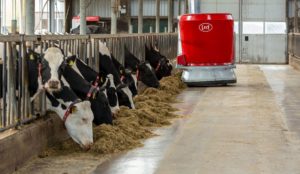The Lely Vector is a robot technology capable of automatically mixing and feeding a self-mixed ration, but what are the benefits of having this technology on farm?
Flexibility
The Lely Vector system allows for great flexibility in both labour and herd management. Andrew Griffiths runs a 400 cow commercial Holstein unit in Cheshire, the whole business evolves around automation, running six A5 milking robots, Lely calm calf feeders and a Vector robotic feeding system. “Investing in automation has given us both labour and kit savings, when milking in the parlour we had a good team of six plus part-timers, nowadays myself, herd manager, Dave Hastings and two-part time staff manage the entire operation. The vector replaced a tractor drawn tub feeder. Reduced time and diesel have cut fixed costs over threefold. It means the system paid for itself quite easily within the first four years after installation in 2015. Equally important, automation has enabled me to spend more time with our young children now aged 11 and 7 years.”
Collective and accurate data
Accurate historic and live data is always provided by the Lely Vector system. NWF Agriculture Technical Manager Abbi England has been working with the business for a number of years “the level of automation gives us so much feedback on how each group of cows is responding to the formulated ration. It makes diet adjustments to silage changes very easy, and accurate daily feed costings reports help the business make management decisions on feed input”.
Animal performance
A big benefit of the Lely Vector is the ability to individually feed each group of animals on the farm. “We run up to 8 different rations through the vector each day, that wouldn’t have been possible with the tub mixer,” says Andrew. Abbi believes the extra detail in specific group rationing is a key contributing factor to the business’s success. “Particularly the heifers. In the winter we have 5 different heifer rations, the benefits of individual age group feeding really do show when they enter into the milking herd” says Abbi.
The system is not only continually mixing and feeding out small amounts of fresh feed, but also providing every animal with the same opportunity. “The milking cows are fed between 14 to 21 times a day, little and often, always ensuring the same accurately mixed ration is available 24 hours a day,” says Andrew. Abbi is a cow signals master trainer and explains “The cow signals concept tries to encourage farmers to do 6+ pushups a day, but this system really overachieves that, as a result, intakes are excellent and you won’t find a calmer herd of cows”.
Apart from cost savings and solving potential labour issues, since introducing the technology the unit has been able to improve overall herd performance. “We have become better herd managers; Dave checks the Lely software each morning so any issues are immediately flagged up. We rarely have a ketosis case, annual mastitis incidence has been reduced by over 15%, selective dry cow therapy has replaced blanket treatment and fertility has significantly improved” explains Andrew.
It is not uncommon to see a 5% to 15% increase in pregnancy rates with the vector. The stabilisation of rumen pH that smaller, more frequent meals deliver results in better utilisation of energy and increased pregnancy rates. “On the old parlour and tub mixer system the herd would float between 30-35% pregnancy rate but now they are consistently over 40% with a 369 calving interval,” says Andrew.
Reduced feed waste
The Lely Vector with the aid of a proprietary laser, measures feed height at the barrier and delivers more of the ration as and when required. This method results in several benefits including; reduction of feed waste, impeccable accuracy and consistency, increased overall operating cost efficiencies and, most importantly, improved rumen health.
Reducing feed wastage has a significant effect on the return on investment (ROI) drivers for automated feeding. It is not uncommon for feed wastage to go from the typical 3% to 5% in a traditional TMR-fed herd to 1% or less with an automated feeding system. “We clean out the troughs every two weeks and end up with just a barrowful; previously we spent 30 minutes every day and cleaned out up to 100kg of waste,” says Andrew.
Reliability
Reliability is always a key component in any feeding system, Lely can give 24-hour support to your farm 7 days a week.
For more information visit the Lely website to find your local branch. http://www.lely.com/gb

